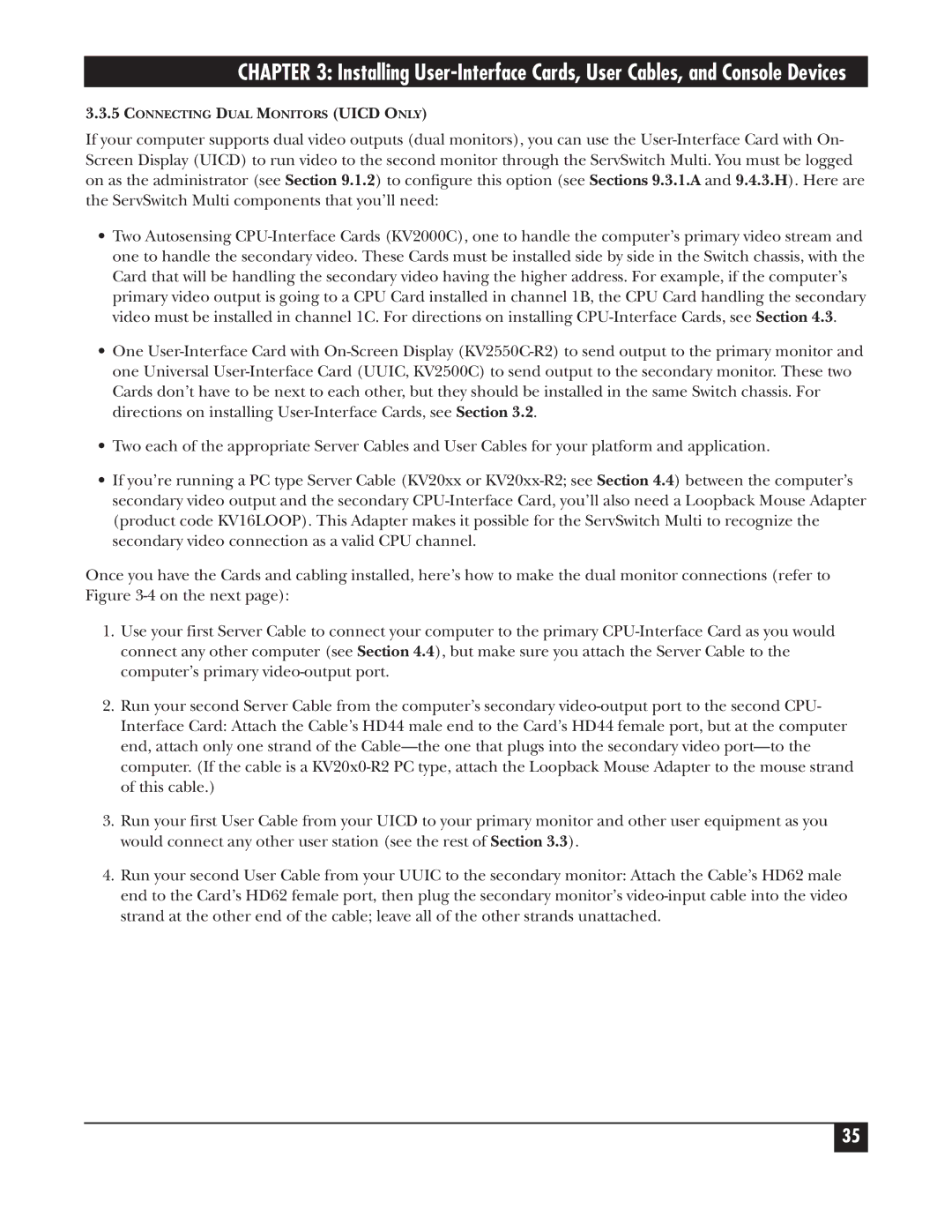CHAPTER 3: Installing User-Interface Cards, User Cables, and Console Devices
3.3.5CONNECTING DUAL MONITORS (UICD ONLY)
If your computer supports dual video outputs (dual monitors), you can use the User-Interface Card with On- Screen Display (UICD) to run video to the second monitor through the ServSwitch Multi. You must be logged on as the administrator (see Section 9.1.2) to configure this option (see Sections 9.3.1.A and 9.4.3.H). Here are the ServSwitch Multi components that you’ll need:
•Two Autosensing CPU-Interface Cards (KV2000C), one to handle the computer’s primary video stream and one to handle the secondary video. These Cards must be installed side by side in the Switch chassis, with the Card that will be handling the secondary video having the higher address. For example, if the computer’s primary video output is going to a CPU Card installed in channel 1B, the CPU Card handling the secondary video must be installed in channel 1C. For directions on installing CPU-Interface Cards, see Section 4.3.
•One User-Interface Card with On-Screen Display (KV2550C-R2) to send output to the primary monitor and one Universal User-Interface Card (UUIC, KV2500C) to send output to the secondary monitor. These two Cards don’t have to be next to each other, but they should be installed in the same Switch chassis. For directions on installing User-Interface Cards, see Section 3.2.
•Two each of the appropriate Server Cables and User Cables for your platform and application.
•If you’re running a PC type Server Cable (KV20xx or KV20xx-R2; see Section 4.4) between the computer’s secondary video output and the secondary CPU-Interface Card, you’ll also need a Loopback Mouse Adapter (product code KV16LOOP). This Adapter makes it possible for the ServSwitch Multi to recognize the secondary video connection as a valid CPU channel.
Once you have the Cards and cabling installed, here’s how to make the dual monitor connections (refer to Figure 3-4 on the next page):
1.Use your first Server Cable to connect your computer to the primary CPU-Interface Card as you would connect any other computer (see Section 4.4), but make sure you attach the Server Cable to the computer’s primary video-output port.
2.Run your second Server Cable from the computer’s secondary video-output port to the second CPU- Interface Card: Attach the Cable’s HD44 male end to the Card’s HD44 female port, but at the computer end, attach only one strand of the Cable—the one that plugs into the secondary video port—to the computer. (If the cable is a KV20x0-R2 PC type, attach the Loopback Mouse Adapter to the mouse strand of this cable.)
3.Run your first User Cable from your UICD to your primary monitor and other user equipment as you would connect any other user station (see the rest of Section 3.3).
4.Run your second User Cable from your UUIC to the secondary monitor: Attach the Cable’s HD62 male end to the Card’s HD62 female port, then plug the secondary monitor’s video-input cable into the video strand at the other end of the cable; leave all of the other strands unattached.

